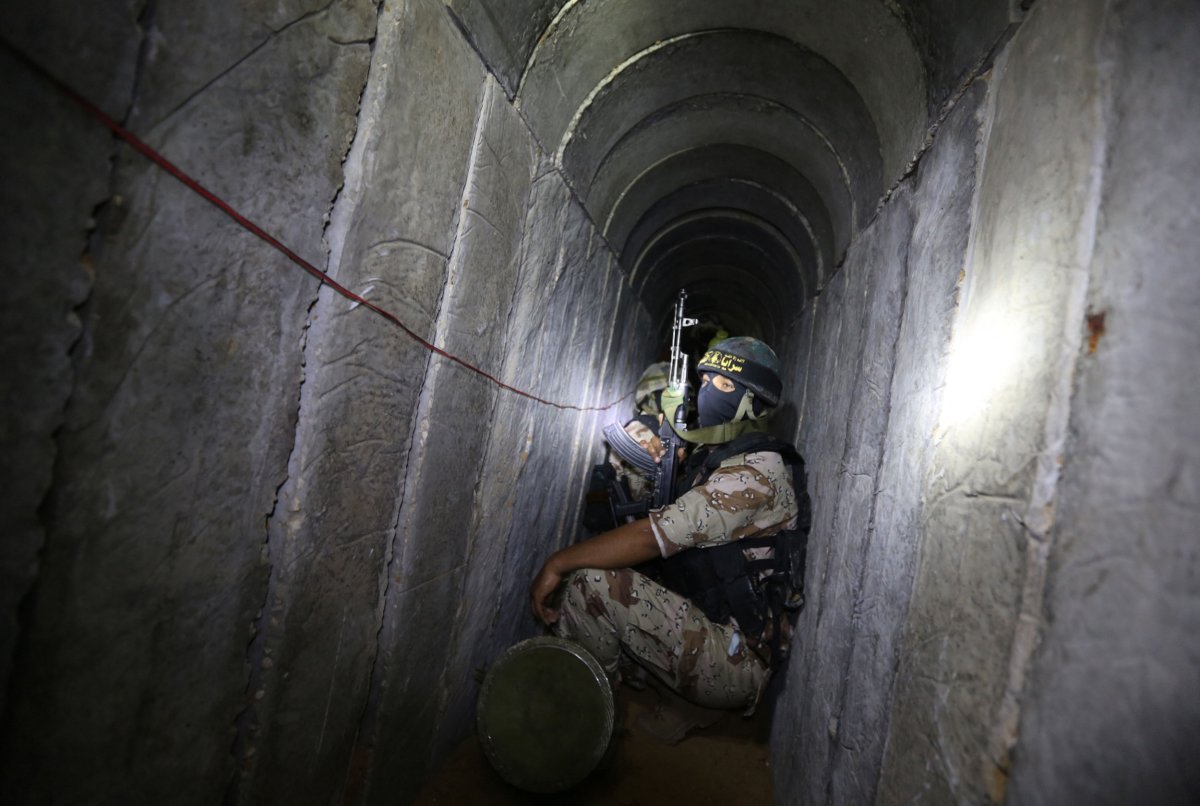The Israel Defense Forces conducted an operation at al-Shifa hospital in the Gaza Strip to root out Hamas terrorists recently, once again taking unique precautions as it entered the facility to protect the innocent; Israeli media reported that doctors accompanied the forces to help Palestinian patients if needed. They were also reported to be carrying food, water and medical supplies for the civilians inside.
None of this meant anything to Israel's critics, of course, who immediately pounced. The critics, as usual, didn't call out Hamas for using protected facilities like hospitals for its military activity. Nor did they mention the efforts of the IDF to minimize civilian casualties.
In their criticism, Israel's opponents are erasing a remarkable, historic new standard Israel has set. In my long career studying and advising on urban warfare for the U.S. military, I've never known an army to take such measures to attend to the enemy's civilian population, especially while simultaneously combating the enemy in the very same buildings. In fact, by my analysis, Israel has implemented more precautions to prevent civilian harm than any military in history—above and beyond what international law requires and more than the U.S. did in its wars in Iraq and Afghanistan.
The international community, and increasingly the United States, barely acknowledges these measures while repeatedly excoriating the IDF for not doing enough to protect civilians—even as it confronts a ruthless terror organization holding its citizens hostage. Instead, the U.S. and its allies should be studying how they can apply the IDF's tactics for protecting civilians, despite the fact that these militaries would almost certainly be extremely reluctant to employ these techniques because of how it would disadvantage them in any fight with an urban terrorist army like Hamas.

The predominant Western theory of executing wars, called maneuver warfare, seeks to shatter an enemy morally and physically with surprising, overwhelming force and speed, striking at the political and military centers of gravity so that the enemy is destroyed or surrenders quickly. This was the case in the invasions of Panama in 1989, Afghanistan in 2001, Iraq in 2003 and the failed illegal attempt by Russia to take Ukraine in 2022. In all these cases, no warning or time was given to evacuate cities.
In many ways, Israel has had to abandon this established playbook in order to prevent civilian harm. The IDF has telegraphed almost every move ahead of time so civilians can relocate, nearly always ceding the element of surprise. This has allowed Hamas to reposition its senior leaders (and the Israel hostages) as needed through the dense urban terrain of Gaza and the miles of underground tunnels it's built.
Hamas fighters, who unlike the IDF don't wear uniforms, have also taken the opportunity to blend into civilian populations as they evacuate. The net effect is that Hamas succeeds in its strategy of creating Palestinian suffering and images of destruction to build international pressure on Israel to stop its operations, therefore ensuring Hamas' survival.
Israel gave warning, in some cases for weeks, for civilians to evacuate the major urban areas of northern Gaza before it launched its ground campaign in the fall. The IDF reported dropping over 7 million flyers, but it also deployed technologies never used anywhere in the world, as I witness firsthand on a recent trip to Gaza and southern Israel.
Israel has made over 70,000 direct phones calls, sent over 13 million text messages and left over 15 million pre-recorded voicemails to notify civilians that they should leave combat areas, where they should go, and what route they should take. They deployed drones with speakers and dropped giant speakers by parachute that began broadcasting for civilians to leave combat areas once they hit the ground. They announced and conducted daily pauses of all operations to allow any civilians left in combat areas to evacuate.
These measures were effective. Israel was able to evacuate upwards of 85 percent of the urban areas in northern Gaza before the heaviest fighting began. This is actually consistent with my research on urban warfare history that shows that no matter the effort, about 10 percent of populations stay.
As the war raged on, Israel began giving out its military maps to civilians so they could conduct localized evacuations. This, too, has never been done in war. During my recent visit to Khan Yunis, Gaza, and the IDF civilian harm mitigation unit in southern Israel, I observed as the army began using these maps to communicate each day where the IDF would be operating so civilians in other areas would stay out of harm's way.
I saw that the IDF even tracked the population in real time down to a few-block radius using drone and satellite imagery and cell phone presence and building damage assessments to avoid hitting civilians. The New York Times reported in January that the daily civilian death toll had more than halved in the previous month and was down almost two-thirds from its peak.
Of course, the true number of Gaza civilian deaths is unknown. The current Hamas-supplied estimate of over 31,000 does not acknowledge a single combatant death (nor any deaths due to the misfiring of its own rockets or other friendly fire). The IDF estimates it has killed about 13,000 Hamas operatives, a number I believe credible partly because I believe the armed forces of a democratic American ally over a terrorist regime, but also because of the size of Hamas fighters assigned to areas that were cleared and having observed the weapons used, the state of Hamas' tunnels and other aspects of the combat.
That would mean some 18,000 civilians have died in Gaza, a ratio of roughly 1 combatant to 1.5 civilians. Given Hamas' likely inflation of the death count, the real figure could be closer to 1 to 1. Either way, the number would be historically low for modern urban warfare.
The UN, EU and other sources estimate that civilians usually account for 80 percent to 90 percent of casualties, or a 1:9 ratio, in modern war (though this does mix all types of wars). In the 2016-2017 Battle of Mosul, a battle supervised by the U.S. that used the world's most powerful airpower resources, some 10,000 civilians were killed compared to roughly 4,000 ISIS terrorists.
And yet, analysts who should know better are still engaging in condemnation of the IDF based on the level of destruction that's still occurred—destruction that is unavoidable against an enemy that embeds in a vast tunnel system under civilian sites in dense urban terrain. This effects-based condemnation or criticism is not how the laws of war work, or violations determined. These and other analysts say the destruction and civilian causalities must either stop or be avoided in an alternative form of warfare.
Ironically, the careful approach Israel has taken may have actually led to more destruction; since the IDF giving warnings and conducting evacuations help Hamas survive, it ultimately prolongs the war and, with it, its devastation.
Israel has not created a gold standard in civilian harm mitigation in war. That implies there is a standard in civilian casualties in war that is acceptable or not acceptable; that zero civilian deaths in war is remotely possible and should be the goal; that there is a set civilian-to-combatant ratio in war no matter the context or tactics of the enemy. But all available evidence shows that Israel has followed the laws of war, legal obligations, best practices in civilian harm mitigation and still found a way to reduce civilian casualties to historically low levels.
Those calling for Israel to find an alternative to inflicting civilian casualties to lower amounts (like zero) should be honest that this alternative would leave the Israeli hostages in captivity and allow Hamas to survive the war. The alternative to a nation's survival cannot be a path to extinction.
John Spencer is chair of urban warfare studies at the Modern War Institute (MWI) at West Point, codirector of MWI's Urban Warfare Project and host of the "Urban Warfare Project Podcast." He served for 25 years as an infantry soldier, which included two combat tours in Iraq. He is the author of the book "Connected Soldiers: Life, Leadership, and Social Connection in Modern War" and co-author of "Understanding Urban Warfare."
The views expressed in this article are the writers' own. They are not necessarily the views of the Department of Defense, the Department of the Army, Army University, or the U.S. Military Academy.
Uncommon Knowledge
Newsweek is committed to challenging conventional wisdom and finding connections in the search for common ground.
Newsweek is committed to challenging conventional wisdom and finding connections in the search for common ground.
About the writer
To read how Newsweek uses AI as a newsroom tool, Click here.








